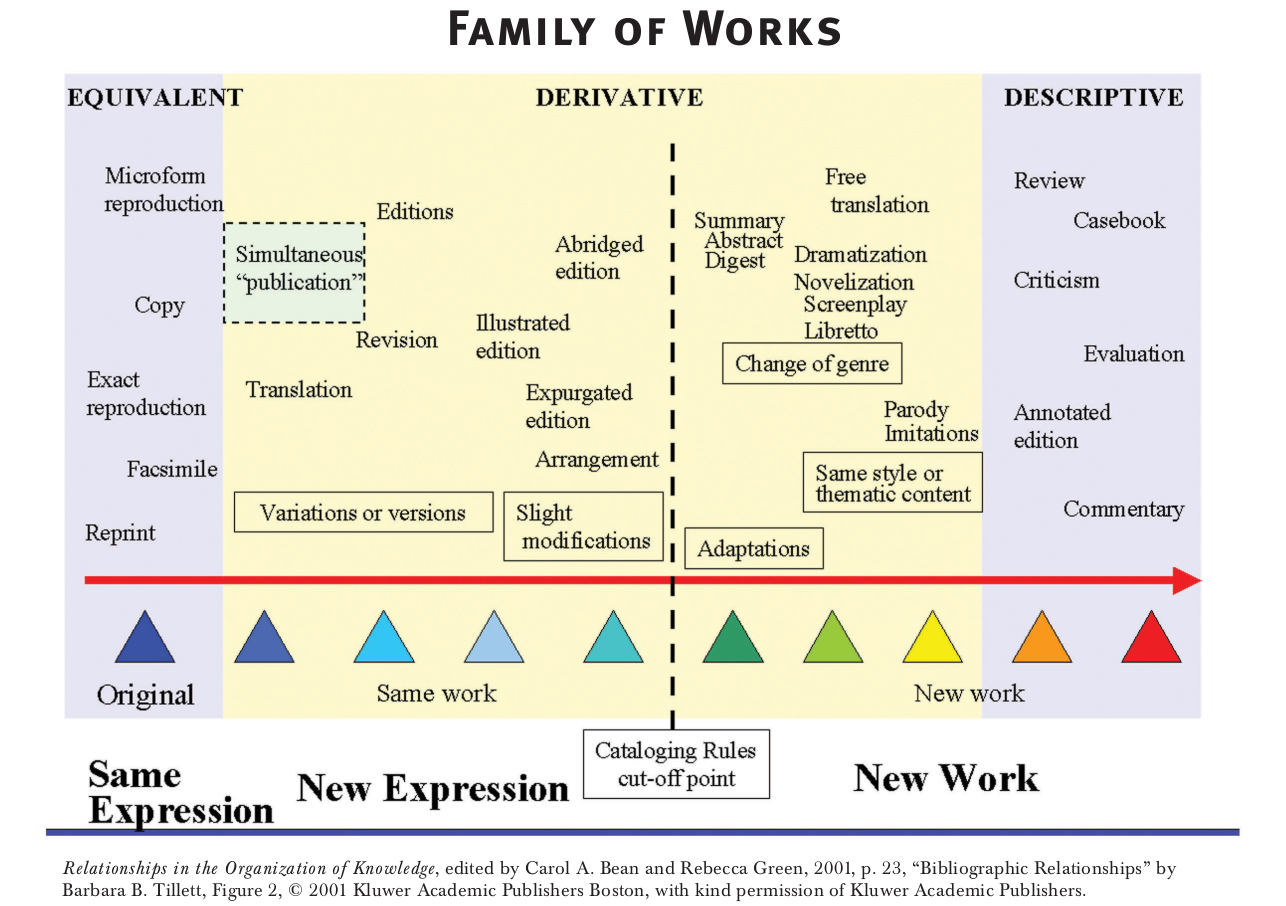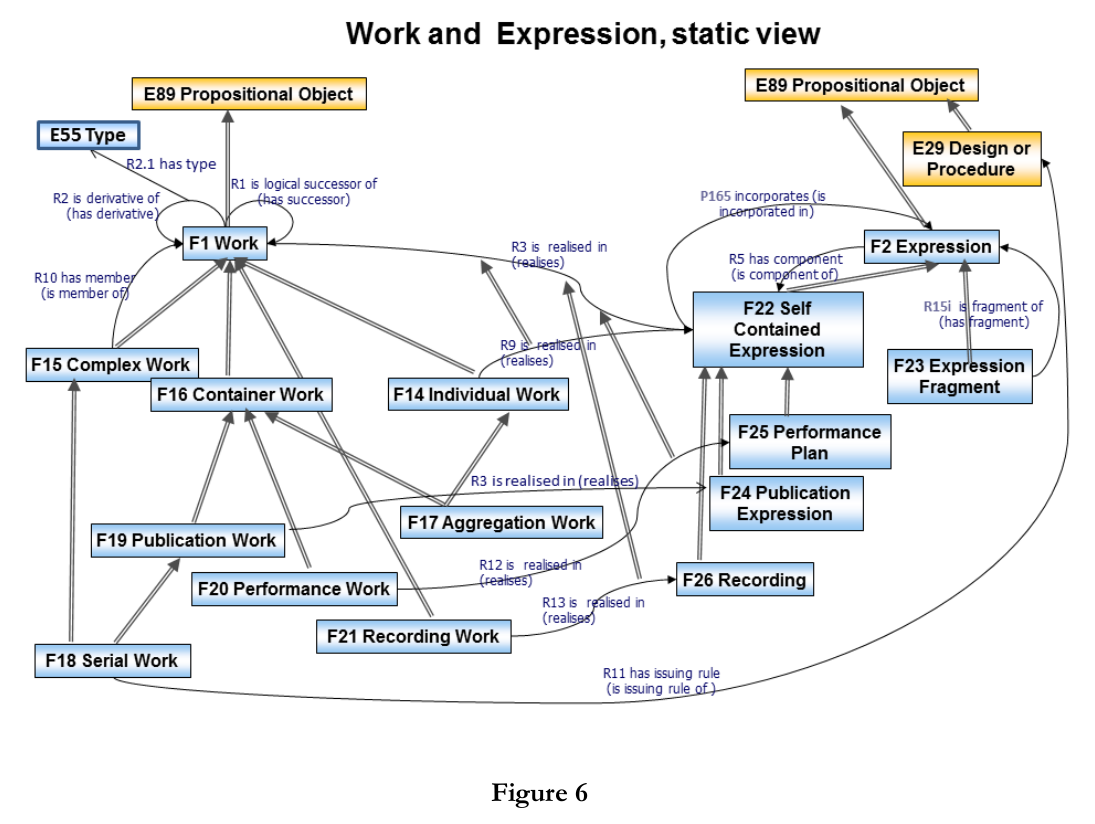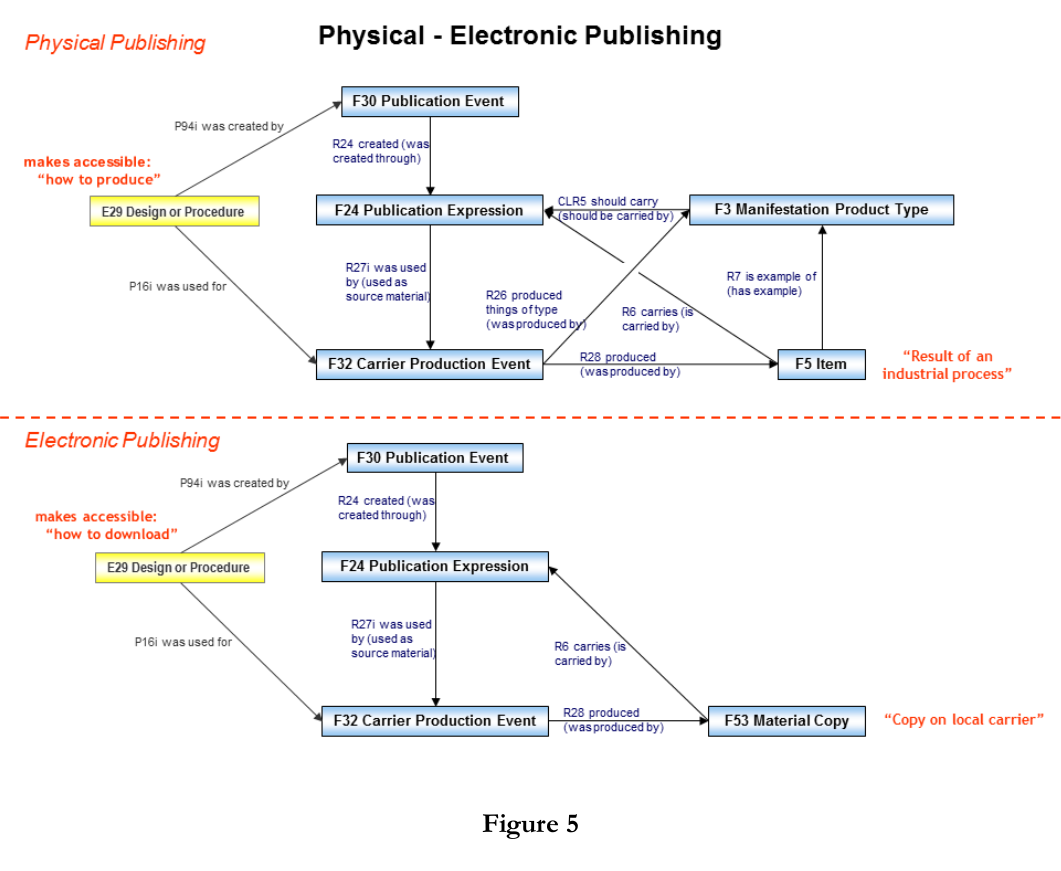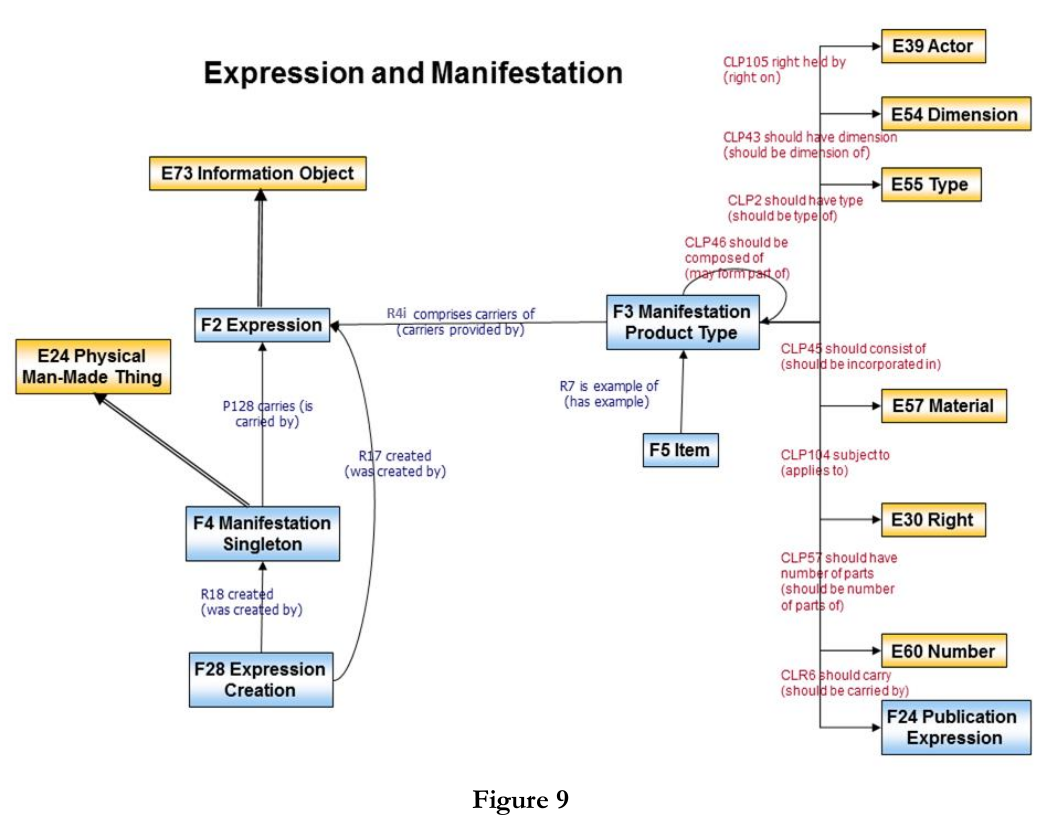FRBR#
FBFR#
FBFR: Functional Requirements for Bibliographic Records
Historischer Ausgangspunkt: Im Bibliothekswesen aus der Vorinternet-Zeitalter werden u.A. vier Dinge unterschieden:
Werk
Expression
Manifestation
Item
Group 1 entities are the foundation of the FRBR model:
Work is a “distinct intellectual or artistic creation.” For example, Beethoven’s Ninth Symphony apart from all ways of expressing it is a work. When we say, “Beethoven’s Ninth is magnificent!” we generally are referring to the work.
Expression is “the specific intellectual or artistic form that a work takes each time it is ‘realized.’” An expression of Beethoven’s Ninth might be each draft of the musical score he writes down (not the paper itself, but the music thereby expressed).
Manifestation is “the physical embodiment of an expression of a work. As an entity, manifestation represents all the physical objects that bear the same characteristics, in respect to both intellectual content and physical form.” The performance the London Philharmonic made of the Ninth in 1996 is a manifestation. It was a physical embodiment even if not recorded, though of course manifestations are most frequently of interest when they are expressed in a persistent form such as a recording or printing. When we say, “The recording of the London Philharmonic’s 1996 performance captured the essence of the Ninth,” we are generally referring to a manifestation.
Anmerkung JB: Gemäß FRNF_oo werden in FBFR “Manifestationen” mehrdeutig verwendet. In FRBR_oo wird daher unterschieden zwischen der physikalischen Entity F4 Manifestation Singleton und der nicht-physikalischen Entity F3 Manifestation Product Type.
Item is “a single exemplar of a manifestation. The entity defined as item is a concrete entity.” Each copy of the 1996 pressings of that 1996 recording is an item. When we say, “Both copies of the London Philharmonic’s 1996 performance of the Ninth are checked out of my local library,” we are generally referring to items.
Auf DE: Bibliographische Entitäten, Merkmale und Beziehungen der Gruppe 1.

Quelle: Tillett, Barbara: What is FRBR? A Conceptual Model for the Bibliographic Universe. originally published in Technicalities v. 25, no. 5 (Sept./Oct. 2003). https://www.loc.gov/cds/downloads/FRBR.PDF. Auf DE auch in https://wiki.k10plus.de/download/attachments/203128868/Modul_1_Wiederholung_pica_swb.pdf, Slide 30
FRBR_oo Version 2.4#
Chryssoula Bekiari et. al. (Ed.): Definition of FRBR OO. A Conceptual Model for Bibliographic Information in Object-Oriented Formalism. Version 2.4, November 2015. https://www.ifla.org/wp-content/uploads/2019/05/assets/cataloguing/FRBRoo/frbroo_v_2.4.pdf.
Lizenz: CC BY 4.0.
Die Seitenangaben der Zitate beziehen sich auf die pdf-Datei frbroo_v_2.4.pdf.
(In Selbstanwendung: Die pdf-Datei frbroo_v_2.4.pdf dürfte eine frbr:Manifestation resp. ein frbr-oo:F3 Manifestation Product Type sein?).
Übersicht#


Autor vs. Publisher Context#
F4 Manifestation Singleton Subclass of: E24 Physical Man-Made Thing This class comprises physical objects that each carry an instance of F2 Expression, and that were produced as unique objects, with no siblings intended in the course of their production.
When a national bibliographic agency creates a single record for both hardcover and paperback presentations of the same content, that record describes an instance of
F24 Publication Expression, and two distinct instances of F3 Manifestation Product Type. […] In the case of electronic publishing, since there is no instance ofF3 Manifestation Product Typeinvolved (see below, 1.2.3), the bibliographic record can only describe an instance ofF24 Publication Expression. (S.20)

Electronic Publishing#
The
F5 Itemscreated through physical publishing are the results of an industrial process. As such they are produced by anF32 Carrier Production Eventand carry anF24 Publication Expression, yet are also examples of anF3 Manifestation Product Typewhich CLR6 should carry theF24 Publication Expression.
In electronic publishing, in contrast, the instances of
F53 Material Copy, which are copies on local carriers, still carry theF24 Publication Expressionand are produced by anF32 Carrier Production Eventwithout there being anyF3 Manifestation Product Typeinvolved in the process.

An instance of F1 Work begins to exist from the very moment an individual has the initial idea that triggers a creative process in his or her mind. This is modelled as:
F27 Work ConceptionR16 initiated (was initiated by)F1 Work. (p.27, Hervorhebung JB)
Unless a creator leaves at least one physical sketch for his or her work, the very existence of that instance of
F1 Workgoes unnoticed, and there is nothing to be catalogued. At least one instance ofF2 ExpressionthatR3i realisesthe instance ofF1 Workhas to be created. This is modelled as:
F28 Expression CreationR19 created a realisation of (was realised through)F1 Work, and
F28 Expression CreationR17 created (was created by)F2 Expression.
Except for oral tradition and recording in human memory, this very first instance of the respective
F2 Expressionwould be created simultaneously on a physical carrier, typically as a unique item or as an electronic file on a specific computer. This is modelled as:
F28 Expression Creation* R18 created (was created by)*F4 Manifestation Singleton, as detailed in Figures 8 and 9.
Alle Zitate aus p.27, Hervorhebung JB


F2 Expression#
This class comprises the intellectual or artistic realisations of works in the form of identifiable immaterial objects, such as texts, poems, jokes, musical or choreographic notations, movement pattern, sound pattern, images, multimedia objects, or any combination of such forms that have objectively recognisable structures. The substance of F2 Expression is signs.
Expressions cannot exist without a physical carrier, but do not depend on a specific physical carrier and can exist on one or more carriers simultaneously. Carriers may include human memory. (p.55)
LRM_oo#
FRBROO version 2.4 was endorsed as an official IFLA standard in 2016. Since the publication of IFLA LRM, work is underway to update FRBROO to align with IFLA LRM. The third version will be named LRMOO. https://www.ifla.org/g/bcm-rg/working-group-on-frbr-cidoc-crm-harmonization/
Mehr: IFLA LRM
cidoc-crm#
CIDOC Conceptual Reference Model (CRM)
Since December, 2006, it has been recognized as an official ISO standard. This status was renewed in 2014 and can be found at ISO 21127:2014.
Die Seitenangaben der Zitate beziehen sich nicht auf ein Werk aus cidoc-crm, sondern auf die Manifestation frbroo_v_2.4.pdf.
E28 Conceptual Object#
This class comprises non-material products of our minds and other human produced data that have become objects of a discourse about their identity, circumstances of creation or historical implication. The production of such information may have been supported by the use of technical devices such as cameras or computers.
Characteristically, instances of this class are created, invented or thought by someone, and then may be documented or communicated between persons.
Instances of E28 Conceptual Object have the ability to exist on more than one particular carrier at the same time, such as paper, electronic signals, marks, audio media, paintings, photos, human memories, etc.
They cannot be destroyed. They exist as long as they can be found on at least one carrier or in at least one human memory. Their existence ends when the last carrier and the last memory are lost.
Examples:
Beethoven’s ‘Ode an die Freude’ (Ode to Joy), (E73)
the definition of “ontology” in the Oxford English Dictionary
(p.200)

Quelle: www.cidoc-crm.org/ » The Model » Use&Learn » Functional Overview » Entity Search » “conceptual” » Reference Information
E73 Information Object#
This class comprises identifiable immaterial items, such as a poems, jokes, data sets, images, texts, multimedia objects, procedural prescriptions, computer program code, algorithm or mathematical formulae, that have an objectively recognizable structure and are documented as single units. An E73 Information Object does not depend on a specific physical carrier, which can include human memory, and it can exist on one or more carriers simultaneously. Instances of E73 Information Object of a linguistic nature should be declared as instances of the E33 Linguistic Object subclass. Instances of E73 Information Object of a documentary nature should be declared as instances of the E31 Document subclass. (p.218)
E31 Document#
Subclass of: E73 Information Object This class comprises identifiable immaterial items that make propositions about reality. These propositions may be expressed in text, graphics, images, audiograms, videograms or by other similar means. Documentation databases are regarded as a special case of E31 Document. This class should not be confused with the term “document” in Information Technology, which is compatible with E73 Information Object. (p.202)
E90 Symbolic Object#
This class comprises identifiable symbols and any aggregation of symbols, such ascharacters, identifiers, traffic signs, emblems, texts, data sets, images, musical scores, multimedia objects, computer program code or mathematical formulae that have an objectively recognizable structure and that are documented as single units.
It includes sets of signs of any nature, which may serve to designate something, or to communicate some propositional content. An instance of E90 Symbolic Object does not depend on a specific physical carrier, which can include human memory, and it can exist on one or more carriers simultaneously.
(p.222)
Ontologien für FRBR#
frbr_deutsch_09.pdf#
Funktionale Anforderungen an bibliografische Datensätze. Abschlussbericht der IFLA Study Group on the Functional Requirements for Bibliographic Records. Februar 2009. ISBN 978-3-941113-05-3. Backlink: urn:nbn:de:101-2009022600
oft verlinkt, aber nicht mehr verfügbar: http://www.d-nb.de/standardisierung/pdf/frbr_deutsch_09.pdf
aktuelle URL: https://d-nb.info/993023320/34
Vorgehen: Wir durchsuchen frbr_deutsch_09.pdf nach Erläuterungen zu wichtigen Begriffen aus FRBR, und identifizieren:
Unterscheidungen
charakteristische Merkmale
typische Beispiele
Übersicht#
Die Entitäten, die als Werk (eine einheitliche intellektuelle bzw. künstlerische Schöpfung) und Expression (die intellektuelle bzw. künstlerische Realisierung eines Werkes) definiert sind, spiegeln den intellektuellen bzw. künstlerischen Inhalt wider. (S. 12)
Unterscheidungen:
Schöpfung vs. Realisierung
intellektuell vs. künstlerisch
Die Entitäten hingegen, die als Manifestation (die physische Verkörperung einer Expression eines Werkes) und Exemplar (ein einzelnes Stück einer Manifestation) definiert sind, spiegeln die physische Form wider. (S. 12)
Unterscheidungen:
physische Verkörperung (einer Expression (eines Werkes)) vs. einzelnes Stück (einer Manifestation)
Unterscheidungen zwischen beiden Abschnitten:
Inhalt vs. Form
Werk#
Ein Werk ist eine abstrakte Entität; es gibt keinen entsprechenden materiellen Gegenstand. (16)
Unterscheidungen:
abstrakt vs. materiell
Wenn man von der Ilias des Homer als einem Werk spricht, ist der Bezugspunkt kein bestimmter Vortrag oder Text des Werkes, sondern die intellektuelle Schöpfung, die hinter den verschiedenen Expressionen des Werkes steht.
Unterscheidungen:
Vortrag oder Text vs. intellektuelle Schöpfung “hinter” verschiedenen Expressionen
Für diese Studie werden Textvarianten, zu denen Überarbeitungen und Aktualisierungen gehören, einfach als Expressionen desselben Werkes betrachtet (d. h. sie werden nicht als separate Werke angesehen). (16f)
Wenn hingegen die Veränderung eines Werkes in hohem Maße eine unabhängige, intellektuelle oder künstlerische Anstrengung beinhaltet, wird das Ergebnis im Rahmen dieser Studie als ein neues Werk angesehen. (17)
Merkmal:
unabhängige, intellektuelle oder künstlerische Anstrengung
Expression#
Expression: die intellektuelle bzw. künstlerische Realisierung eines Werkes in Form von Buchstaben, Zahlen, Noten, Choreografien, Tönen, Bildern, Gegenständen, Bewegungen usw. oder einer Kombination dieser Formen. Eine Expression ist die spezifische intellektuelle bzw. künstlerische Form, die ein Werk jedes Mal annimmt, wenn es realisiert wird. (18f)
Gleichermaßen werden Kürzungen oder Erweiterungen eines schon existierenden Textes bzw. das Hinzufügen von Teilen oder einer Begleitung zu einer musikalischen Komposition als unterschiedliche Expressionen desselben Werkes betrachtet. Übersetzungen in andere Sprachen, musikalische Transkriptionen und Bearbeitungen sowie synchronisierte bzw. mit Untertiteln versehene Filme werden ebenfalls nur als unterschiedliche Expressionen desselben ursprünglichen Werkes betrachtet. (Erläuterung zu Werk, S. 17)
Weil die Form einer Expression eine wesentliche Eigenschaft der Expression ist, führt jede Veränderung der Form (z. B. von einer textlichen Darstellung zum gesprochenen Wort) zu einer neuen Expression. (19)
Expressionen lassen sich also nach Form unterscheiden (und ggf. klassifizieren): BINGO!
Ebenso führen Veränderungen an intellektuellen Konventionen bzw. Instrumenten, die verwendet werden, um ein Werk auszudrücken (z. B. eine Übersetzung in eine andere Sprache) zur Schaffung einer neuen Expression. Wenn ein Text bearbeitet oder modifiziert wird, wird die daraus resultierende Expression als eine neue Expression angesehen. (19)
Manifestation#
Manifestation: es handelt sich um die physische Verkörperung einer Expression eines Werkes. (21)
Charakteristisches Merkmal: physische Verkörperung? NEIN, hier ist der Standard bekanntermaßen unscharf. Auflösung:
Mithilfe der als Manifestation definierten Entität kann man die physischen Eigenschaften einer Charge von Exemplaren beschreiben. [ Dies ermöglicht es Benutzern, ] ein einzelnes Stück dieser Manifestation nachzuweisen und zu erwerben. (23)
Unterscheidung:
Charge von Exemplaren vs. einzelne Stücke
Ergänzung aus frbr_oo: ZITAT der persönlichen Kommunikation
Exemplar#
Exemplar: ein einzelnes Stück einer Manifestation.
Unterschied: Das Einzelne (hier: Stück) vs. eine Gruppe (hier: von Stücken)
Die als Exemplar definierte Entität ist eine konkrete Entität.
Unterschied: konkret vs. abstrakt (?)
In Bezug auf den intellektuellen Inhalt und die physische Form gleicht ein Exemplar, das zu einer Manifestation gehört, normalerweise der Manifestation selbst. Es kann trotzdem Unterschiede zwischen Exemplaren geben, auch wenn die Exemplare zu einer einzigen Manifestation gehören.
JB: Die Manifestation ist die Menge aller Exemplare, die eine bestimmte Menge von Eigenschaften teilen.
Die Definition von Exemplar als eine Entität ermöglicht die separate Identifizierung von einzelnen Exemplaren einer Manifestation sowie die Beschreibung der Eigenschaften, die nur dieses Stück hat und die alle Transaktionen mit diesem Stück betreffen, wie beispielsweise die Ausleihe usw. (24)
Unterschiede:
Eigenschaften, die kennzeichnend sind für eine Charge, vs. zufällige Eigenschaften
Charge von Stücken mit gemeinsamer physischer Form vs. einzelne Exemplare, Stücke
Begriff (26), Gegenstand (26), Ereignis (27), Ort (28)#
Begriff: ein abstrakter Gedanke bzw. eine Idee. (26)
Gegenstand: ein materielles Ding.
Ereignis: eine Aktion oder Begebenheit.
Ort: eine geografische Ortsangabe. (28)
Für diese Studie werden Begriffe [JB: ebenso Gegenstände, Ereignisse, Orte] nur dann als Entitäten behandelt, wenn sie Thema eines Werkes sind (26)
Die Definition der Entität Begriff [JB: ebenso Gegenstand, Ereignis, Ort] ermöglicht die konsequente Bezeichnung bzw. die Identifizierung eines Begriffs [Gegenstands, Ereignisses, Ortes], unabhängig vom Vorliegen oder der Form der Bezeichnung des Begriffs [Gegenstands, Ereignisses, Ortes] auf oder in einer bestimmten Expression bzw. Manifestation eines Werkes. (26)
Unterschiede:
Begriff [Gegenstands, Ereignis, Ort] vs. seine Bezeichnung
in Expressionen und Manifestationen kommen nur Bezeichnungen vor
Begriffe [Gegenstände, Ereignisse, Orte] sind “Thema” eines Werkes
Diskussion#
Nicht alle Unterschiede sind relevant … irrelevant z.B. offensichtlich intellektuell vs. künstlerisch: Das wird immer im Sinne der Vereinigungsmenge intellektuell und/oder künstlerisch vewendet.
Relevante Unterschiede:
Inhalt vs. Form
abstrakt vs. materiell